Ojoma Ekhomun knew the birth of her first child was going to be difficult – just as she went for her six-month check-up and scan, Nigeria went into lockdown. What she did not expect at that appointment in March, was to find herself back at the hospital less than a month later going into labour just 31 weeks into her pregnancy.
Her tiny, premature son weighed just 1lb 8oz (700g) when he was delivered through caesarean section. He was underdeveloped and his low weight made him extremely vulnerable. According to doctors, the baby boy – named Akahomhen – was the smallest child to have been cared for at the Amuwo Odofin Maternal and Child Centre in Lagos, where he was transferred immediately after being born.
In the days that followed, Akahomhen's weight dropped to 1lb 5oz (600g) and his doctors were concerned. Around 205 babies die in Nigeria every day as a result of being born premature – accounting for 31% of all neonatal deaths in the country.
Despite being Africa's biggest economy, poor investment in health infrastructure, coupled with limited access to maternity services in some areas, means that neonatal mortality in the country is among the highest in the world. Rural areas in particular have high rates of maternal and newborn deaths.
Fortunately for Ekhomun's son, the Amuwo Odofin Maternal and Child Centre is one of the more modern facilities in the country. Doctors were able to put her son into an incubator – often in short supply in Nigeria – and slowly his weight began to rise. But just as he reached 2lbs 3oz (1kg) – still a critically low weight for a newborn – they took him out.
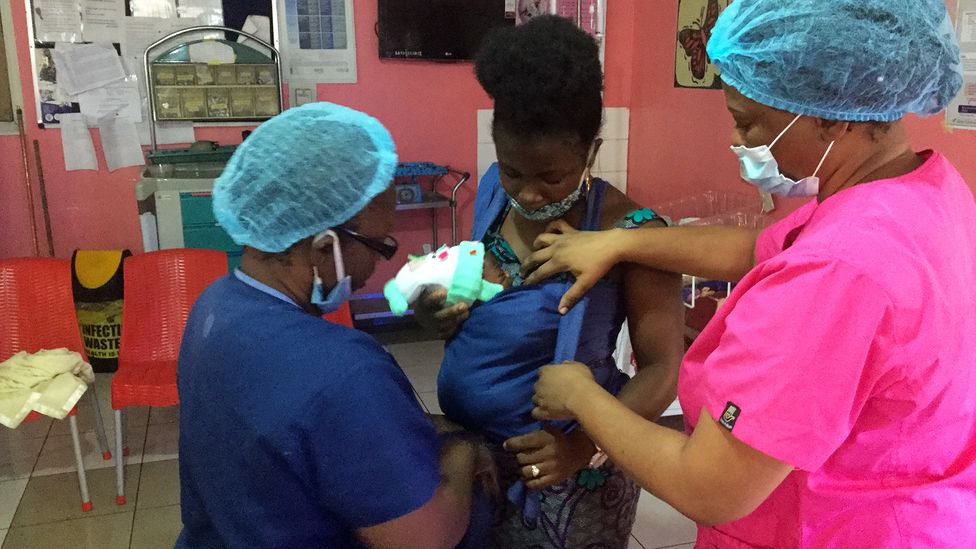
Ojoma Ekhomun has cared for her little boy using kangaroo mother care after he was born premature (Credit: Ayodele Johnson)
Instead, the doctors bundled him against his mother’s chest, their naked skin pressed against each other. Ekhomun carried him like this everywhere she went over the following weeks, unwrapping him only to breast feed and to sleep.
Slowly her son began gaining weight, putting on around 1oz (30g) a day until he weighed 3lbs 15oz (1.8kg) at 60 days old. Initially he had to be fed through a syringe, but gradually he began to breastfeed. Over the following months, Ekhomun continued to carry her son swaddled next to her skin as grew into a healthy, bouncing baby.
"He is very safe there," says the 26-year-old mother. "I enjoy the heat between the baby and myself."
This simple, but remarkably effective approach – known as "kangaroo care" due to the way the baby is carried on the mother’s front – is regarded as one of the best alternatives to incubators when caring for premature and low-weight babies.
"We have about 19 randomised trials from all over the world that show a reduction in deaths," says Joy Lawn, a professor of maternal, reproductive and child health at the London School of Hygiene and Tropical Medicine in the UK. "Most of those trials have focused on babies who are already less sick. They are still preterm but they are not very ill."
Lawn has spent over a decade researching the benefits of kangaroo care, particularly in Africa. Her research suggests kangaroo care can provide a lifeline to premature babies in rural and hard-to-reach communities where access to incubators is limited.
But she believes the approach is vastly under-used and could also be of benefit in more developed countries to ease pressure on overstretched neonatal intensive care units.
"It is not just for low-resourced settings," says Lawn.
You might also like:
- Why the way you talk to children matters
- The effect of childbirth no one talks about
- The secret to being a good father
Underweight, premature babies can face a wide range of problems when they are born. Without a store of body fat, they can struggle to regulate their own temperature and lose heat rapidly. Incubators are used to help them maintain a stable temperature.
By affixing the baby in an upright position to its mother's chest so their skin is in direct contact, it is able to share her body heat to maintain a stable temperature and dramatically reduce the risk of hypothermia in their first days of life.
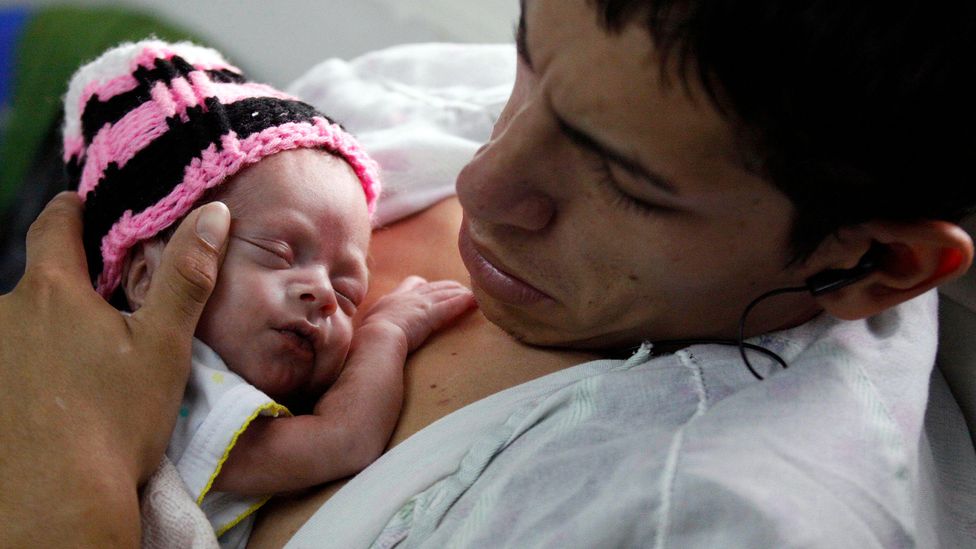
Fathers can take their share of skin-to-skin contact using kangaroo care with similar results to mothers (Credit: Alamy)
First proposed in 1978 by two paediatricians at the maternity unit of the San Juan de Dios Hospital in Bogota, Columbia, kangaroo mother care was initially intended as a way of helping the overstretched wards cope with the high number of premature babies born there. The hospital delivered in the region of 11,000 babies each year and mortality rates were high among these new-borns.
In an effort to ease demand for the incubators, the doctors suggested mothers of low-birth-weight babies have continuous skin-to-skin contact with their infants. Babies cared for in this way appeared to have lower mortality rates and staff were also able to focus on the most critically ill infants.
When the results were published in 1983, they immediately attracted international attention and were widely promoted by the United Nations' Children Fund (Unicef). Initially there were concerns around the robustness of the trial due to the way mortality figures were recorded, but subsequent research around the world has supported those initial results.
As it has been adopted in different countries around the world, more has been learned about its potential benefits. Lawn points to a number of trials which have demonstrated significant improvements in not only mortality rates but also in the subsequent illness of preterm babies.
Across the globe, an estimated 14.8 million babies are born prematurely each year – accounting for around 11% of all births, and the rate of preterm births appears to have been rising – at least in the 14 years between 2000 and 2014 that global figures exist for. Complications related to preterm birth are also the leading cause of death among children, accounting for 18% of deaths of those under the age of five and up to 35% of deaths of babies younger than 28 days.
The rates of pre-term births vary greatly by where in the world you look. Saudi Arabia and Belarus have some of the lowest rates in the world, with around 4% of births being premature, while Bangladesh and Cyprus experience premature birth rates of 19.2% and 18.7% respectively. The greatest burden of premature births – nearly 80% of those worldwide – are found in low and middle-income countries, particularly in sub-Saharan Africa and South Asia, where access to life-saving equipment like incubators is most limited.
Despite the evidence supporting kangaroo care, and an endorsement by the World Health Organization, the technique still struggles to obtain mainstream status in some areas. In Nigeria's north-western state of Kebbi, Unicef is working with midwives to help teach mothers and traditional birth attendants about kangaroo care.
In many hard-to-reach communities, expectant mothers rely upon traditional birth attendants to help deliver and care for their babies during labour. These attendants are usually older local women who rarely have medical training, but are often highly respected within their local communities. Although use of untrained birth attendants has been declining, they are often used due to a shortage of midwives.
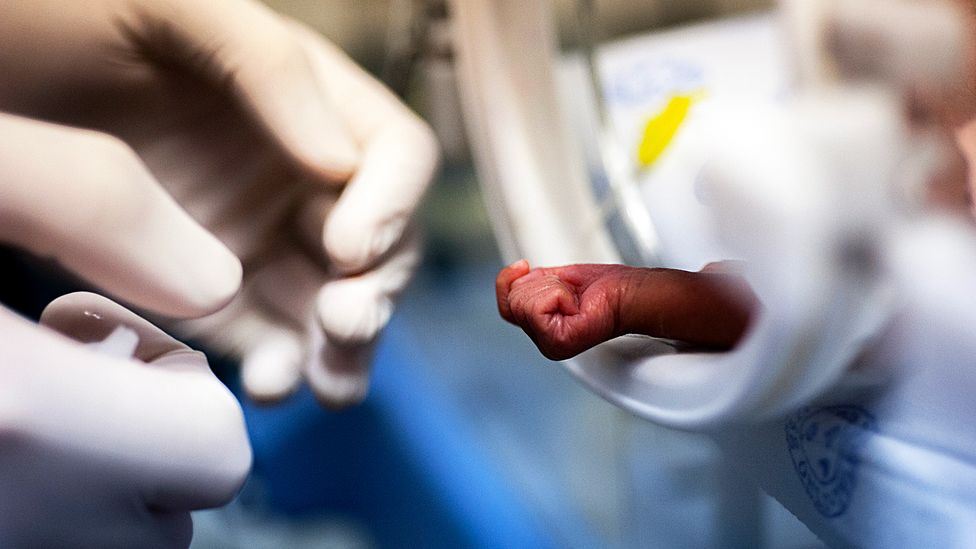
Incubators can save lives by helping to keep underweight premature babies stable but are not available in all parts of the world (Credit: Conrad Bornman/Getty Images)
In most cases they provide invaluable care, but can struggle if there are complications during a birth without the right tools, says Nyam Musa, a midwife with Unicef who leads a team helping to introduce kangaroo care to rural communities in Kebbi. Before the coronavirus disrupted their work, her unit often visited villages in the area to help mothers of underweight babies.
Her team offers lessons to the mothers on how to apply kangaroo care by themselves and with help from family members. They show them how to secure the baby safely with cloth pieces so the child sits against their mother's skin, and offer tips on how to keep them clean in the event of accidents.
But convincing the traditional birth attendants to embrace kangaroo care has involved overcoming many long-held beliefs.
Some believe that if a mother or child dies, "it is just God that made it happen that way", explains Musa. There is also a mindset in many communities that women should avoid attending hospital as a symbol of their strength and prestige, she says.
Despite these challenges, they have found that most are eager to use kangaroo care. "The acceptance is more than the rejection," Musa adds. The Unicef team use case studies – inspiring examples of past successes – to mentor the most sceptical attendants.
But even in areas where incubators are available and primary healthcare centres close by, intermittent electricity supplies can leave equipment effectively useless. Kangaroo care becomes an important tool even in busy city hospitals, says Linda Ethel Nsahtime-Akondeng, health manager for Unicef Nigeria's Maternal Newborn and Child Health Department.
"It is low-cost and can be done at scale," she says. This could prove essential for a country with the third-highest number of premature births in the world behind India and China. An estimated 803,000 children are born prematurely in Nigeria each year, putting enormous pressure on its health care facilities.
Oyejoke Oyapero, head of paediatrics at the Amuwo Odofin Maternal and Child Centre in Lagos, says the technique has helped free up incubators, but she believes having the baby in such close proximity to its mother brings many advantages.
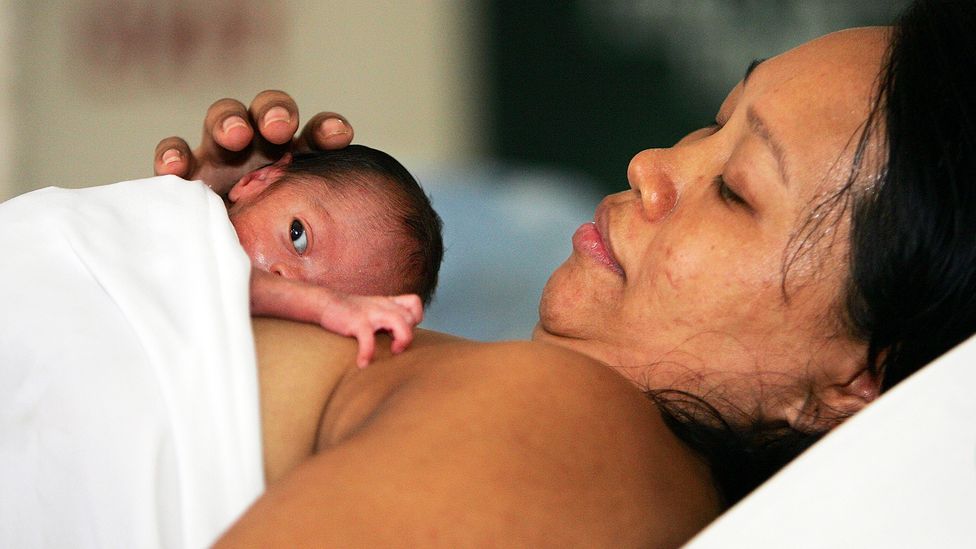
The skin-to-skin contact with their mother can help keep pre-term infants warm but also improves bonding among other benefits (Credit: Paula Bronstein/Getty Images)
"The baby does not need [its] own energy or calories [to stay warm]," she says. "As such, the baby diverts those calories to gaining weight because the mother provides [her own body heat]. Some of the [incubators] come with apnea monitors (to detect if the baby stops breathing). For kangaroo mother care, the mother is all the gadget you need."
But kangaroo care takes commitment – underweight babies require continuous skin-to-skin contact for at least 18 hours per day. For the mother, it means only a few hours' break.
Antin Ehi, a 40-year-old mother from Lagos whose daughter was born prematurely in April this year, has cherished the opportunity to be so close to her little girl, who she has called Ehi. With the help of staff at the Maternal and Child Care Centre in Lagos, Antin Ehi learned to wrap her newborn daughter against her chest with linen as her condition stabilised.
"I never really got to know about it until I found myself in this situation," she says. "And honestly, it was a great experience. We normally would put on a nightgown and put her inside, against my body to feel the warmness. It was funny but it was lovely.
"She can stay there for the whole day. Once you just place them there on your chest, they are just there calm. They don't disturb. They just feel relaxed."
While most of the focus of kangaroo care is on the mother, there is also a growing body of research that suggests fathers can take a share of the skin-to-skin contact with similar results. Lawn also believes that kangaroo care could be useful in helping care for babies yet to completely stabilise after birth, such as those with breathing difficulties or suffering from an illness. She and her colleagues are currently conducting a trial in hospitals in Gambia to see if mild to moderately unwell preterm babies benefit from kangaroo care. In stabilised preterm infants weighing less than 2kg (4.4lbs), kangaroo care has been found to reduce mortality by 36-51%, but there are hopes it could also help babies who are unwell, or even if it can be used within the first hours after birth.
But the close proximity to their mother afforded by kangaroo care seems to bring other benefits for the baby too.
"It reduces the infections that [the baby] can catch in hospitals," says Lawn. "It improves growth. It improves breastfeeding. It improves [the baby's] brain."
Many pre-term babies struggle to breastfeed at first, largely because they have not yet developed the suckling reflex or the ability to coordinate breathing and swallowing as they do so. Mothers of premature babies may also not yet be producing enough milk for their child. This often means premature infants end up fed via tubes while in the incubator.
But kangaroo mother care has been found to help low birthweight infants begin breast feeding earlier – up to 2.6 days according to one review study – than those cared for using incubators or mechanical infant warmers.
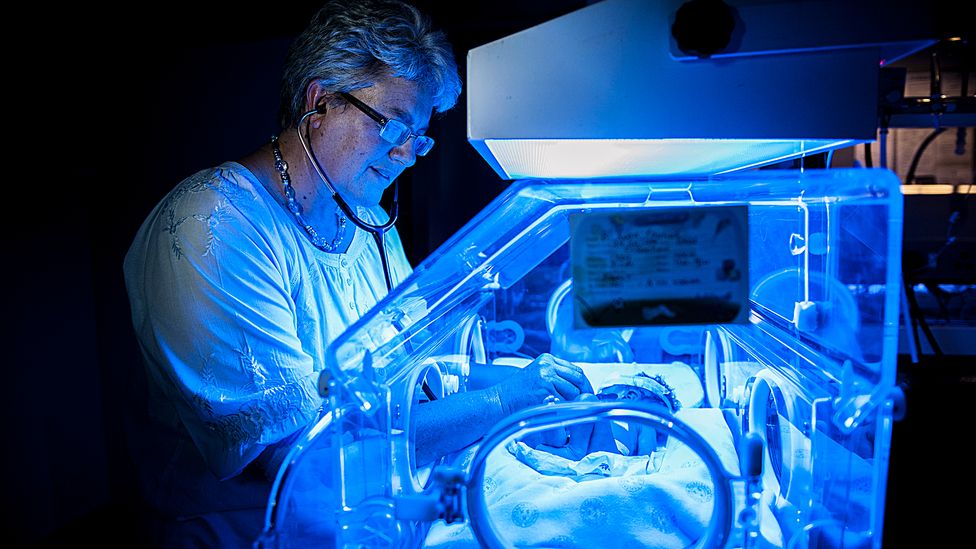
Equipment shortages and unreliable electricity supplies in some parts of the world can mean incubators are not always available (Credit: Conrad Bornman/Getty Images)
One feature that has made it particularly appealing in wealthy, industrialised regions is the sense of empowerment it offers to mothers by being able to participate in the improvement of their pre-term baby compared to incubator care. The technique has also been shown to improve bonding between mother and baby, particularly because it avoids separating women from their newborns in the first days after birth.
Babies who have kangaroo care may even cry less and sleep more peacefully, some small-scale studies have suggested. It has also been linked to brain development, including improved attention and movement. One study has even suggested that feeling the mother's heartbeat helps to synchronise the infants breathing while attached to her chest.
Yet, despite the growing evidence base to support the benefits of kangaroo care, its implementation around the world is patchy, even in developed nations like the US. Fewer than 50% of newborns and mothers receive kangaroo care in US hospitals, according to some admittedly outdated statistics collected by researchers in 2002. According to Lawn, things are changing.
"The governments, probably, that are investing the most in kangaroo mother care are the Scandinavians," she says. "Across Europe and North America, kangaroo mother care is becoming the standard of practice. Either for stable pre-term babies but also for babies who are sick."
For first-time mother Ojoma Ekhomun the technique has allowed her to protect and nurture her baby boy at his most vulnerable. Even now he is out of danger and growing every day, she intends to continue carrying him on her chest.
"I will continue it until [my] baby starts walking," she says. "It is very nice."
--
Join one million Future fans by liking us on Facebook, or follow us on Twitter or Instagram.
If you liked this story, sign up for the weekly bbc.com features newsletter, called "The Essential List". A handpicked selection of stories from BBC Future, Culture, Worklife, and Travel, delivered to your inbox every Friday.
"care" - Google News
February 12, 2021 at 08:03AM
https://ift.tt/3pdPOmY
The life-saving benefits of kangaroo care - BBC News
"care" - Google News
https://ift.tt/2N6arSB
Shoes Man Tutorial
Pos News Update
Meme Update
Korean Entertainment News
Japan News Update
Bagikan Berita Ini














0 Response to "The life-saving benefits of kangaroo care - BBC News"
Post a Comment